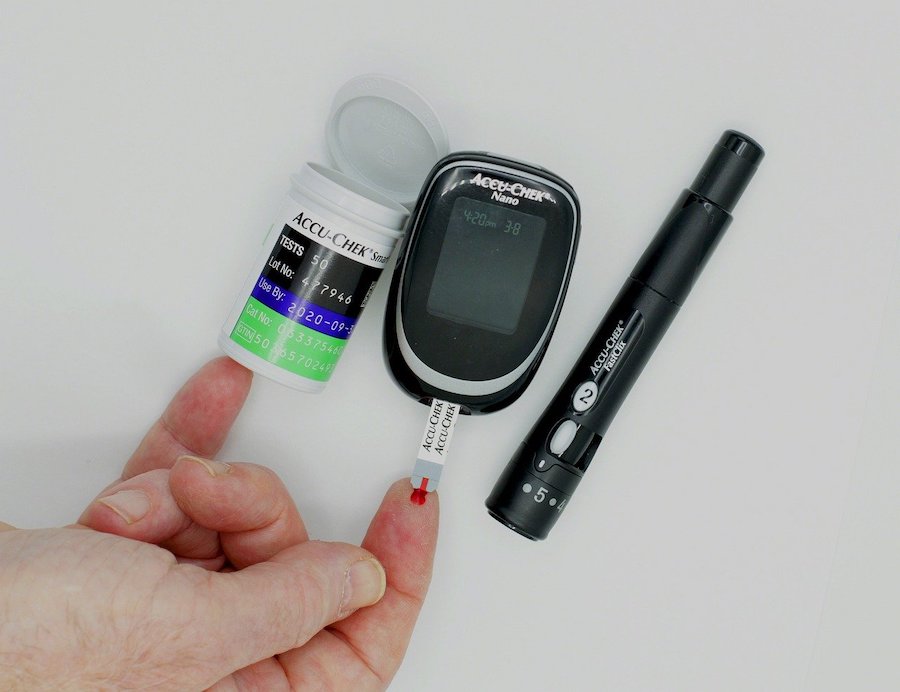What is the need for monitoring Diabetes?
At the beginning Diabetes is often without symptoms. Time and again it has been proved in various scientific studies that uncontrolled Diabetes has a very high risk of developing complications (will be discussing later).
Once complications develop, they do not go away. Diabetes needs to be treated to keep you symptom-free and to prevent future complications. When your sugar control is good, you can be sure that you are doing the correct things. So you must keep on doing the same.
Control Your Diabetes, Do Not Allow Diabetes to Control You
How should I monitor my Diabetes?
There are two main ways of monitoring diabetes control. One is checking your blood sugar either by pricking finger (glucometer) or by blood test in the laboratory.

Finger pricking has the advantage of keeping your control in your hand and is advisable at least to those on insulin and pregnancy Diabetes if not all. The second way of monitoring is by checking HbA1C.
Testing urine glucose is certainly better than nothing and useful for elderly people. A “nil” urine sugar will tell blood sugar is less than 180 mg%. This means if somebody’s sugar control is good urine will always show nil for sugar.
What is HbA1C and how does it help?
If you do a blood sugar test now, it tells us what is the sugar now. It does not tell what was the sugar an hour, a day, one week or a month back. HbA1C is an average measure of the blood sugar.
It is the measure of the sugar that is attached to the haemoglobin. It tells us about the average reading for the last 3-4 months.
So, HbA1C adds to a better assessment of Diabetes control. Please remember that HbA1C does not tell us what your total haemoglobin is.
Is HbA1C cost effective?
In most of the laboratory, it will cost you from Rs 400 to Rs 500. It is certainly much more costly than blood sugar but it adds an extra point to your Diabetes assessment.
The main advantage is HbA1C gives an average reading what ultimately matters in preventing long-term complications. You need to check 3-4 times a year.
How frequently I should check blood sugar?
It is very important to keep an eye on your sugar, wherever you are and whomever doctor you see. In average once in 3 months should be enough to see the control.
If the control is not good and treatment has been changed, you may think of doing more often. On the other hand, if control is very good and you are fine, you may do it every 6 months.
Which sugar is best to check, fasting, after food or random?
Fasting sugar is the most important one. Once fasting is well controlled then you can concentrate on sugar 2 hour after meal [Postprandial (PP)].
PP sugar is particularly important in pregnancy Diabetes. Random sugar checking does not make much sense in monitoring Diabetes, it has only a role to diagnose low sugar (i.e., you are not feeling well and you want to know your sugar on the spot) or a very high sugar like in Diabetic coma.
Who should check sugar at home?
Checking your own sugar at home is a wonderful idea. Having a machine at home does not mean you need to check everyday; you can make a plan how often you want to do. This is reliable and there is no reason to cross checks your home sugar with the laboratory.
The best advantage of having a glucometer at home is to check your sugar when you are not feeling well so that you can know then and there whether blood sugar is the reason for you not feeling well.
Our routine practise is to check sugar once a week, fasting and after breakfast.
How costly is sugar checking at home?
The machine cost now varies from Rs 1,000 to around Rs. 1,500 (quite a few types of machine is now available in India) and a pack of strip cost around Rs 1000 for 50. So in comparison, on the long run checking sugar at home is not more costly.
What are the targets that we need to achieve?
| Tests | Good control | Acceptable control | Needs action |
|---|---|---|---|
| HbA1c | <7.0% | 7-8% | >8% |
| Fasting glucose | 80 – 110 | 110-140 | > 140 |
| PP glucose | < 160mg/dl | 160-200 | > 200 |
Goals are individualized, based on:
- age
- associated medical conditions
- absence of hypoglycaemic symptoms
Is monitoring sugar for pregnant people with diabetes any different?
Yes, in pregnancy we want a tighter sugar control, hence much more frequent monitoring and tighter targets. Plesae refer to the pregnancy section.
Is urine sugar checking helpful?
Urine sugar has its’ particular place in assessing control. Sugar starts appearing in urine when blood sugar exceeds 180 mg%. When you have checked blood sugar, then checking urine sugar at the same time is meaningless.
Urine sugar is of value when for some reason or other you cannot check blood sugar. For example, in the elderly, people with eyesight problem or in cases of economic restraint.
Strips are available to check urine sugar by matching colour. A “nil” will tell your blood sugar is less than 180 mg%. It will not tell how low the blood sugar is. So urine sugar is not helpful in detecting low sugar (Hypoglycaemia). If control is good urine sugar should always be negative.
Can I check my blood sugar without pricking myself?
We are waiting for that day as well. Science is advancing so rapidly. Just think, a few years back Insulin was not available nor the tablets or sugar tests.
Already, research is in progress to see whether we can check sugar by very fine painless puncture (micropuncture) or in saliva and sweat. Let us pray the breakthrough coming soon.